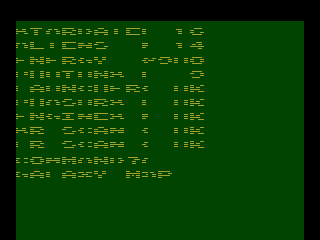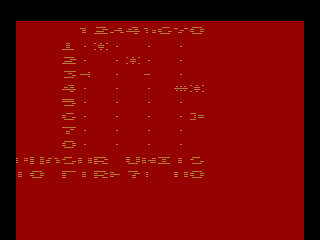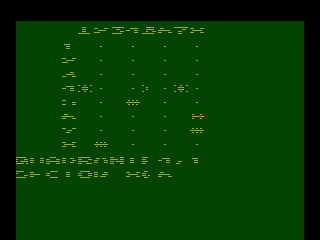Retro Replay Review
Gameplay
Stellar Track hearkens back to the earliest days of computer gaming, offering pure, text-based strategy on the Atari 2600. You start by choosing how many enemy vessels you must destroy within a given number of stardates, pressing Reset or Select and then using the joystick to set your mission parameters. From there, every action—from scanning to firing weapons—requires selecting a command via the joystick and confirming with the red button, then specifying any required parameters in a second joystick move. The turn-based system ensures each decision matters: long-range scans reveal nearby quadrants but may draw enemy fire, while short-range scans give you detail on stars, aliens, and starbases at the risk of immediate attack.
(HEY YOU!! We hope you enjoy! We try not to run ads. So basically, this is a very expensive hobby running this site. Please consider joining us for updates, forums, and more. Network w/ us to make some cash or friends while retro gaming, and you can win some free retro games for posting. Okay, carry on 👍)
Movement in Stellar Track is handled entirely through the Warp command. You assign a direction on a numeric grid laid out around your ship and then tell the computer how many quadrants and sectors to traverse. Miscalculations can strand you against a star obstacle, depleting stardates and energy without changing your position. Docking at a starbase is the only way to fully replenish torpedoes, energy, and repair damage, so plotting efficient warp paths and remembering base locations on the 6×6 galaxy map is crucial to survival.
Offense comes in two forms: photon torpedoes and phasers. Torpedoes offer one-shot kills but require a clear line of sight, while phasers can hit targets behind you but drain your energy reserve based on blast strength. You carry up to nine torpedoes, and each phaser use or torpedo launch counts as a turn—so you must balance aggression with resource management. Additionally, every scan and shot can provoke alien retaliation, amplifying the tactical tension in every encounter.
Adding further depth are the Atari’s two difficulty switches. The right switch adjusts how easily you take damage: in Expert mode, enemy hits are twice as likely to inflict harm. The left switch controls relative phaser strength: in Novice mode your weapons are twice as powerful as the aliens’, whereas in Expert they’re evenly matched. These settings let you tailor the challenge, making Stellar Track approachable for newcomers or punishing for seasoned strategists seeking a true test of command skills.
Graphics
Stellar Track dispenses entirely with graphical sprites or pixel art—the Atari 2600 simply wasn’t built for detailed visuals. Instead, it employs a purely text-based interface reminiscent of college mainframe Star Trek games. All on-screen information appears as characters and numbers, arranged in menus or grids. The 6×6 galaxy map displays two-digit codes in each quadrant: the left digit shows the number of aliens, and the right digit indicates the presence of a starbase. It’s functional, if minimal.
Where the game does add visual variety is through color-coded background screens during warp jumps. A green field indicates an empty quadrant of stars, red warns of enemy presence, and gray signals you’ve landed on a starbase. These simple palettes leverage the Atari’s limited color capabilities to communicate critical information at a glance, making up for the lack of drawn enemy ships or starfield animations.
Though there are no sound effects beyond the Atari’s basic beeps and buzzes, the stark presentation has its own charm. Each text update and color flash carries weight, sharpening your focus on strategy rather than spectacle. For purists and retro enthusiasts, Stellar Track’s aesthetic feels authentic—an exercise in resourceful design rather than a compromise.
Story
Stellar Track offers no cutscenes or spoken dialogue—its narrative is distilled into mission parameters and status reports. You are the captain of a Federation starship tasked with ridding the galaxy of hostile alien vessels before your stardates run out. There’s no onboard computer cabin banter or unfolding character arcs, but the ticking stardate clock and regular status updates create a palpable sense of urgency.
The only storyline emerges from the numbers themselves. Every lost stardate, depleted energy unit, or destroyed alien ships tells a piece of your evolving campaign. Docking at a starbase brings relief and a momentary narrative high, framed by the instant repair and resupply message. Fail to reach the starbase in time, and your ship limps on, systems failing, as each stardate slips away.
In lieu of a scripted plot, imagination fills in the gaps. You might envision Klingon warbirds looming in the distance or picture the cold metal corridors of your own vessel while you crunch numbers and plot courses. It’s a framework that invites you to project your own Star Trek fantasies onto a bare-bones engine, much as early mainframe players did decades ago.
Overall Experience
Stellar Track is not for everyone. Modern players accustomed to hi-def graphics, orchestral scores, and branching narratives may find it austere. But for those drawn to pure strategy, resource management, and the raw flavor of early computing, it offers a uniquely rewarding experience. Every command matters, and the absence of visual clutter keeps you engaged with the core gameplay loop: scan, move, fire, repair, repeat.
The learning curve can be steep. Memorizing numeric directions, managing stardates and energy levels, and tracking starbase positions across a 6×6 grid all require patience and planning. However, once you adapt to the controls and internalize each command’s cost and benefit, Stellar Track becomes a surprisingly deep tactical romp—one you can revisit time and again by tweaking the difficulty switches or altering your kill-quota.
Ultimately, Stellar Track stands as a testament to the ingenuity of early game designers working within severe hardware constraints. It captures the spirit of Star Trek in its emphasis on exploration, crisis management, and triumphant returns to starbases. If you’re a retro gamer, a Star Trek fan, or simply curious about the origins of interactive fiction on consoles, this text-only voyage through the galaxy is well worth charting.
 Retro Replay Retro Replay gaming reviews, news, emulation, geek stuff and more!
Retro Replay Retro Replay gaming reviews, news, emulation, geek stuff and more!









Reviews
There are no reviews yet.